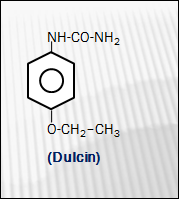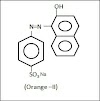Dulcin
(p-phen-ethyl-urea) or sucrol ,or valzin
Dulcin is a artificial
sweetening agent.
Dulcin is 250 times sweeter then our regular sugars.
Dulcin is also known as sucrol and valzin.
It is synthesized from different methods , here we have three well known method for preparation of dulcin .
Discovery
It is discovered in 1883 , by a polish chemist joseph berlinerblau or jozef berlinerblau(1859-1935.)
Dulcin is discovered after five years of saccharine.
Sweetening
agent :
Definition : synthetic organic compound which have a sweet test called sweetening agent .
Or
Artificial Non-saccharide compound which have a sweet test , known as sweetening agent.
Or
Some organic synthetic compounds are not saccharides but they have sweet test, these are called sweetening agents.
|
Natural sweetening agent Some natural organic compounds have naturally sweet test, contains calories and nutrients these are known as natural sweetening agent . Eg. Glucose , sucrose , fructose , honey etc. |
Artificial sweetening agent Some artificial organic compound (but not saccharide) have a sweet test , not have any nutrient value , known as artificial sweetening agents. Eg. Sachharin , aspartame, sucrolose , alitame , p-anisyl-urea , dulsin etc. |
Dulcin is 250 times sweeter then our regular sugars.
Dulcin is also known as sucrol and valzin.
It is synthesized from different methods , here we have three well known method for preparation of dulcin .
Chemical
properties
IUPAC name : (4-ethoxy phenyl) urea .
CAS number : 150-69-6
Structure formula :
Physical
properties :
Molecular formula : C9H12O2N2 .
Molecular weight : 180.20 gm/mole.
Melting point : 173.5oC . OR 446.6 k.
Boiling point : decomposes at normal temperature & pressure or (173oC).
Solubility : water soluble (solubility in water is about 1.25 gm/liter at 25oC).
It is also soluble in alcohol .
Color : white or colorless.
State : solid , white needles or white needle shape crystals powder.
Odor : not specific odor or odorless.
Synthesis of dulcin or sucrol , or valzin.
Method-1
:
Synthesis of dulcin from
p-ethoxy-nitrobenzene .
Statement
:
The reduction of p-ethoxy-nitrobenzene in the presence of metal [Sn} and HCl , gives p-ethoxy-aniline then the reaction of p-ethoxy-aniline with urea(NH2-CO-NH2) Yields our final product dulcin.
Chemical
reaction :
Method-2
Synthesis of dulcin from phenacetin
.
Statement
:
In the reaction the hydrolysis(HCl/H2O) of phenacetin gives 1-(4-ethoxy-phenyl) amine carboxylic acid after that the reaction of 1-(4-ethoxy-phenyl) amine carboxylic acid with SOCl2 and ammonia (NH3) yields dulcin.
Chemical
reaction :
Method-3
Synthesis of dulcin from (4-amino
phenol).
Statement
:
the reaction of 4-amino-phenol with acetic anhydrate(ac2o) and tri-ethyl-ammonia gives 4-ethoxy-amino-phenol then ; the reaction of 4-ethoxy-amino-phenol with (CH3-CH2-Br) in the presence of NaOH gives p-phen-ethyl-amino-methyl-ketone, after that the hydrolysis(H2O/HCl) of p-phen-ethyl-amino-methyl-ketone gives p-phen-ethyl-ammonia , it’s react with urea(NH2-CO-NH2) in the presence of solid Na2CO3 , and acetic acid (CH3-COOH) yields our final product dulcin.
Chemical reaction :
Uses of dulcin :
dulcin is used as a sweeteners , in the place of sugars.
It used in human food .
Note : dulcin is contains some toxic effects on body .
Small amount of dulcin(30-40 gm) causes hypotension , nausea, dizziness.
In a children it is more harmful sometimes it’s deadly poisonous for child.
Side effects of more amount of
dulcin
(i) Headache
(ii) Dizziness
(iii) Nausea
(iv) Skin irritation .
[અસ્તુ:]











![ATENOLOL [TENORMIN] - medicinal drug -study everything.](https://blogger.googleusercontent.com/img/b/R29vZ2xl/AVvXsEgGTsBGKNaP_tE51nfYj2h3fKdZpO02gO5BeGfItb45xXsb4Gs_pu7ojGb8kc5WTo3e8qZHTxUwGLRwVrpBxzY-Bld1uR2rsmHRYEj3fX0uV4dEYiMa_46l17eSkXpgPnWb3pgGvDGvkqBU/w100/structural+formula+atenolol.PNG)

0 Comments
please do not enter any spam link in the comment box.